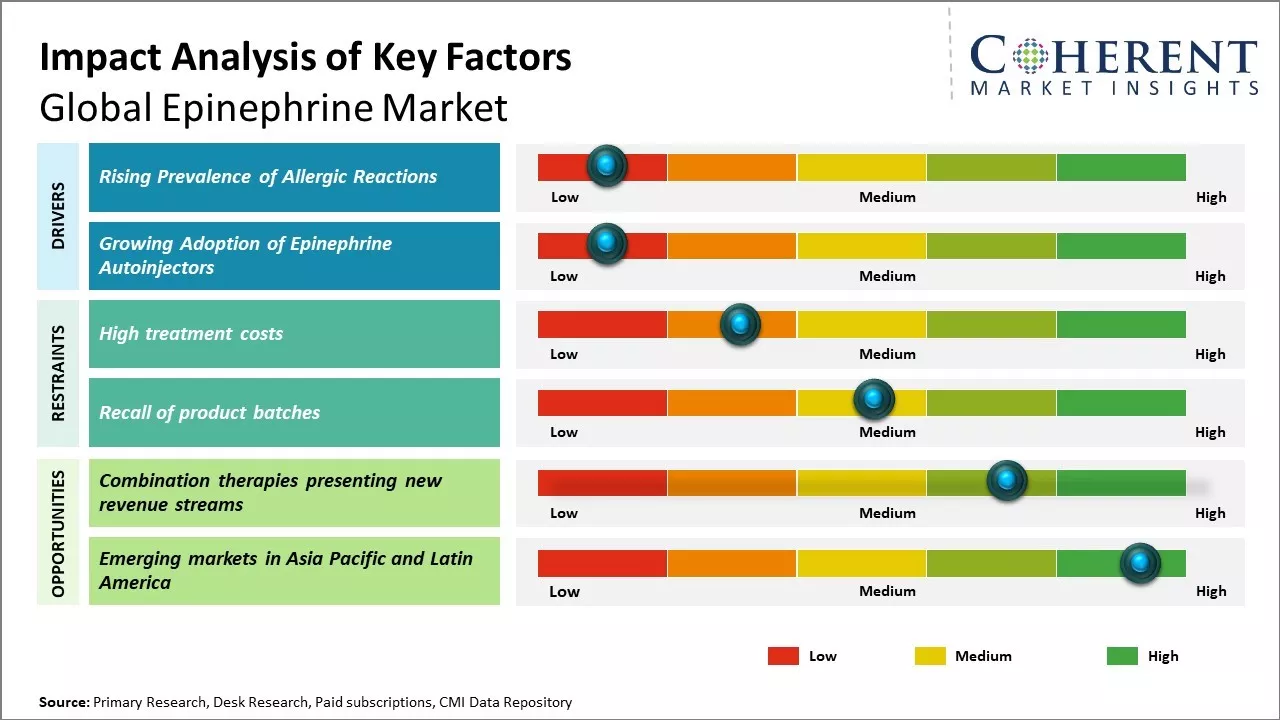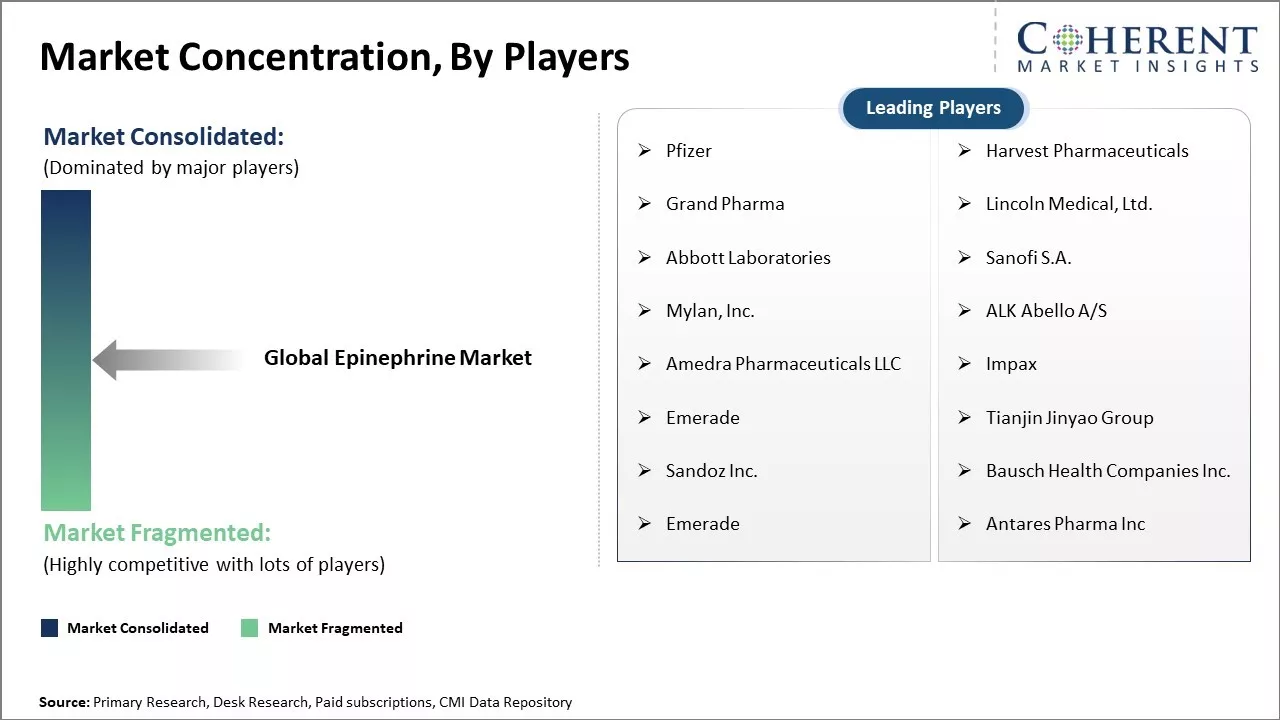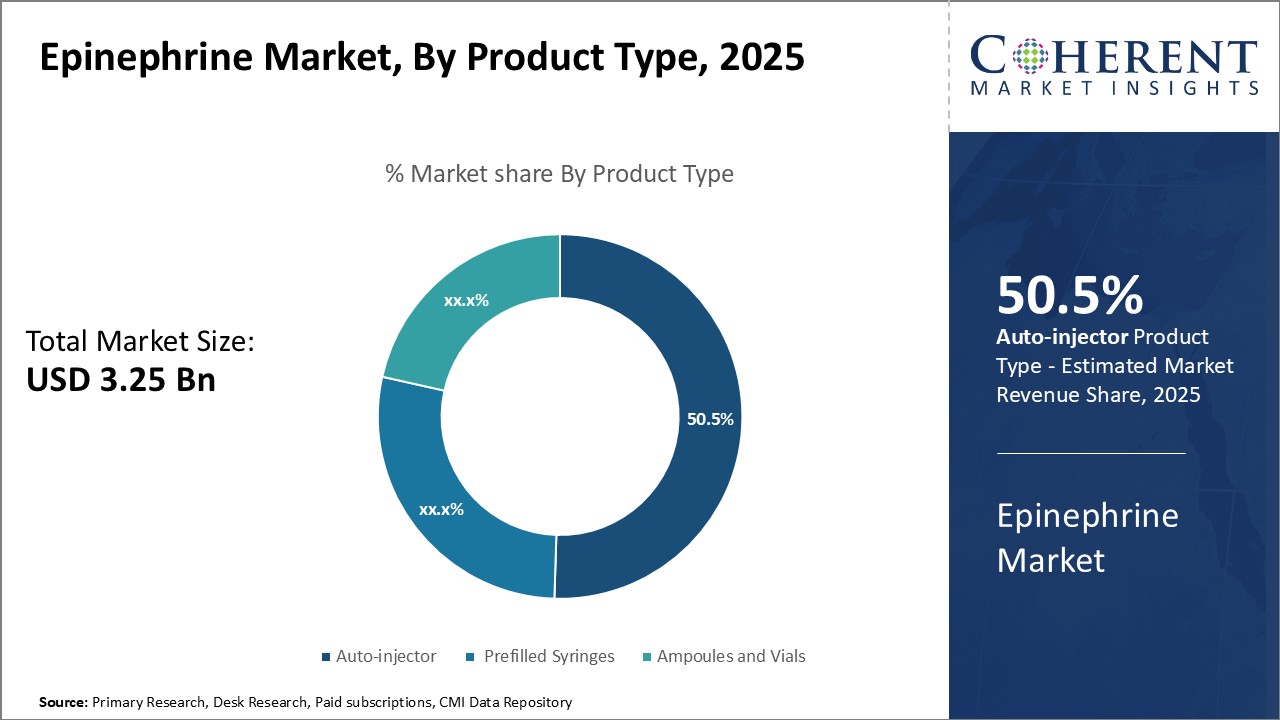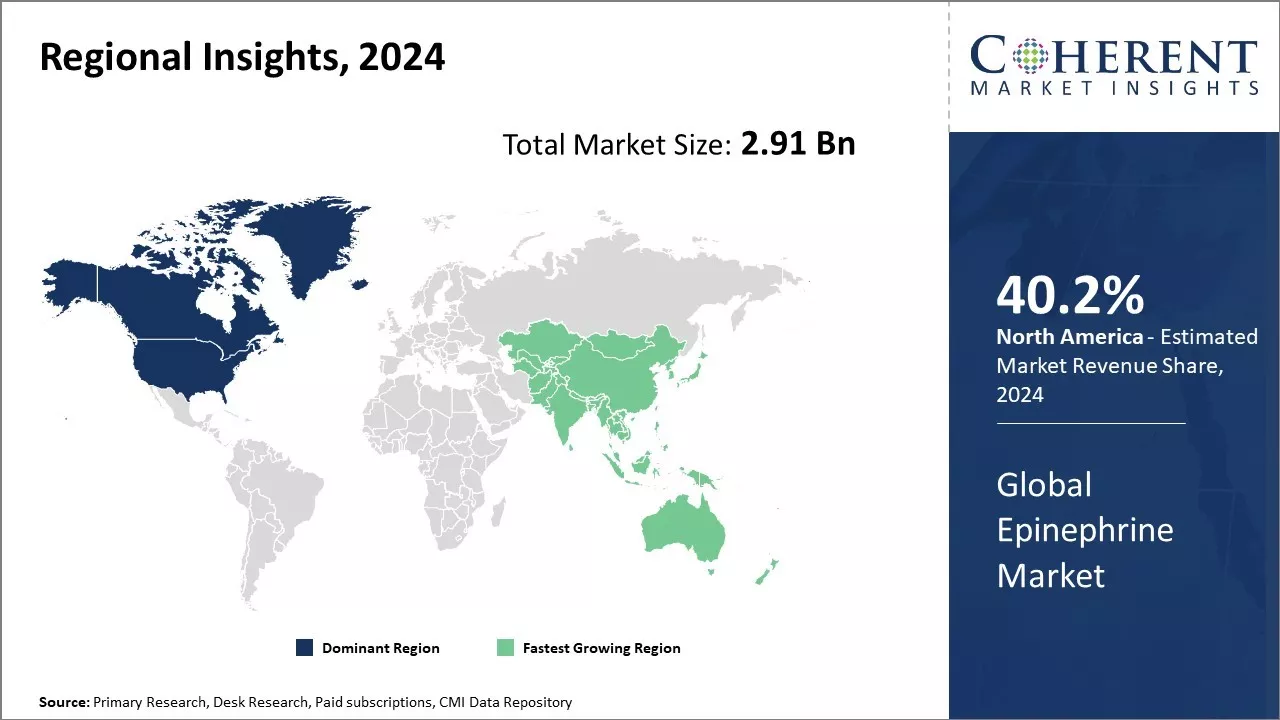Global epinephrine market is estimated to be valued at USD 3.25 Bn in 2025 and is expected to reach USD 7.11 Bn by 2032, exhibiting a compound annual growth rate (CAGR) of 11.8% from 2025 to 2032.

Discover market dynamics shaping the industry: Request sample copy
Rising incidence of life-threatening medical emergencies such as anaphylaxis and cardiac arrests requiring emergency epinephrine injections can drive the market growth. Increasing awareness about early treatment of allergic reactions and availability of user-friendly epinephrine auto-injectors can also boost demand for epinephrine. However, presence of alternative treatment options and risk of side-effects associated with epinephrine administration can hamper the market growth during the forecast period.
Rising prevalence of allergic reactions
Rising prevalence of allergic diseases and conditions can drive the market growth. Allergic reactions can range from mild to severe and life-threatening. Epinephrine, also known as adrenaline, is the first line treatment for emergency medical situations involving severe allergic reactions or anaphylaxis. As more people around the world are developing sensitivities to various allergens such as food, drugs, insect bites and stings, there have been rising instances of anaphylaxis. This has contributed to greater awareness among the public as well as healthcare providers about the need to have immediate access to epinephrine auto-injectors, especially in developed markets. Community programs and school policies in many countries now mandate stocking and training for epinephrine administration. This boosts demand for low-cost generic as well as brand name epinephrine products that allow for self-administration during allergic emergencies. In 2021, according to the data published by CDC or Centers for Disease Control and Prevention, there has been high rates of seasonal allergies, eczema, and food allergies among U.S. adults and children. Ethnic disparities are notable, with Black, Non-Hispanic individuals showing higher prevalence of food allergies. These findings emphasize the need for targeted interventions and policies to address allergy disparities effectively.

Get actionable strategies to beat competition: Request sample copy
Growing adoption of epinephrine autoinjectors
Traditionally, epinephrine for treating allergic reactions was only available in ampoules or vials that needed to be drawn up and administered via intramuscular injection. This posed several difficulties during emergency situations when seconds matter the most. The development of easy-to-use pre-filled epinephrine autoinjectors has revolutionized the management of anaphylaxis. Autoinjectors remove the need for drawing up medication from a vial and allow for hands-free self-administration through clothing, even by non-healthcare individuals. Modern autoinjectors feature voice instructions, thus, making them suitable for use by adults as well as children experiencing symptoms. With their convenience and ease of administration, epinephrine autoinjectors have gained widespread acceptance among medical professionals and the public. Multiple device upgrades and new entrants by leading pharmaceutical companies have further expanded access and availability of these devices globally. This boosts demand for epinephrine, especially for products packaged in autoinjector formats.
Key Takeaways from Analyst:
Rising prevalence of allergies, asthma and anaphylaxis worldwide can boost demand for epinephrine medications and devices. Increasing awareness about these medical conditions and availability of user-friendly epinephrine auto-injectors can drive the market growth. North America region currently dominates the market, owing to presence of major market players and favorable reimbursement policies for epinephrine prescriptions. However, Asia Pacific region is predicted to emerge as the fastest growing market due to improving healthcare infrastructure and growing healthcare spending in major countries like China and India.
Lack of availability and affordability of epinephrine medications in underdeveloped regions can hamper the market growth during the forecast period. Furthermore, recall of certain generic epinephrine drugs by regulatory authorities over quality issues can also hamper the market growth. Ongoing R&D for developing novel therapeutics, devices and trainer devices and increasing collaborations between industry players and researchers can offer new opportunities for epinephrine market growth globally in the near future. Rising merger and acquisition activities within leading players for business expansion can also drive the market growth.
Market Challenges: High treatment costs
The high treatment costs can hamper the global epinephrine market growth. Epinephrine, also known as adrenaline, is a hormone and medication that is widely used to treat allergic reactions including anaphylaxis. The production of epinephrine requires complex manufacturing processes and stringent quality standards to ensure efficacy and safety. This makes the production of epinephrine a highly specialized process. Thus, only a few big pharmaceutical companies have the capabilities and resources to produce epinephrine. This oligopolistic market structure enables these major producers to influence pricing. Furthermore, the patents on major epinephrine products provide market exclusivity and discourage price competition for extended periods. Rising research and development expenditures of pharmaceutical companies have also contributed to increased treatment costs. Developing new and improved formulations such as auto-injectors, that are easier for patients to use, require huge investments. These R&D costs are ultimately passed on to the consumers in the form of high drug prices. According to the United Nations International Children's Emergency Fund (UNICEF), manufacturing costs of epinephrine increased over five times faster than inflation between 2007-2015.
Market Opportunities: Combination therapies presenting new revenue streams
Combination therapies can offer new revenue streams in the global epinephrine market. With ongoing research in life sciences, innovative drug delivery mechanisms are paving way for more effective treatment protocols. Combining epinephrine with other rescue medications enables synergistic therapeutic responses and assures maximum clinical benefits for patients. Some of the leading manufacturers are exploring multi-drug formations involving epinephrine to expand the application scope and overcome existing limitations. For example, certain combination inhalers now allow epinephrine to be conveniently self-administered for asthma exacerbations. Epinephrine auto-injectors combined with antihistamines are proving efficacious in reversing severe allergic reactions. The ability to tackle co-occurring symptoms simultaneously through single-dose combinations boosts treatment outcomes.

Discover high revenue pocket segments and roadmap to it: Request sample copy
By Product Type - Convenience and Portability Boosts Demand for Auto-injector
In terms of product type, auto-injector segment is estimated to contribute the highest market share of 50.5% in 2025, owing to their convenience and portability. Auto-injectors allow for self-administration of epinephrine during an anaphylactic reaction without the need for assembly or handling of loose needles. This ease of use makes auto-injectors preferable for patients, especially those at higher risk such as children, or for situations away from medical supervision. Their compact size and ergonomic shape also enables auto-injectors to be easily stored and carried, in backpacks or purses, so that epinephrine treatment is immediately available when needed. Various initiatives by drugmakers to develop similiar user-friendly devices have raised awareness about them. Due to their huge demand in emergency medical cases, auto-injectors remain the preferred product type of epinephrine market.
By Application - Anaphylaxis Dominates Epinephrine Application
In terms of application, anaphylaxis segment is estimated to contribute the highest market share of as it is primary condition treated by epinephrine. Anaphylaxis is a severe, potentially life-threatening allergic reaction that can occur within minutes of exposure to an allergen. Common triggers include foods, medications, insect stings or bites. As the prevalence of food allergies and insect venom allergies rises globally, there will cases of anaphylaxis. Epinephrine injection via auto-injector is the first-line treatment for anaphylaxis. Its alpha- and beta-adrenergic effects help reverse multiple symptoms such as low blood pressure, breathing difficulties and skin reactions. Awareness programs educate people about prompt epinephrine administration in anaphylaxis emergencies, thus, boosting their demand.
By Distribution Channel - Hospital Pharmacies Dominate Distribution
In terms of distribution channel, hospital pharmacies segment is estimated to contribute the highest market share of as patients commonly obtain epinephrine prescriptions or refills from hospital outpatient pharmacies due to factors like – hospitals employ specialists such as allergists and immunologists who diagnose and manage conditions requiring epinephrine treatment such as anaphylaxis. Patients are also educated on appropriate epinephrine use and demonstrate techniques before being discharged. Hospital setting also allows direct supervision over administration technique and dosage. Even for maintenance needs, the coordinated care and insurance coverage benefits ensure continued fills through affiliated hospital outlets.

Need a Different Region or Segment? Customize now
North America dominates the global epinephrine market and accounts for highest market share of 41.8% in 2025. The region has strong presence of key market players as well as suppliers and manufacturers in the industry. High epinephrine prescription rates and increasing adoption of epinephrine auto-injectors for emergency treatment of allergic reactions drives the market growth in the region. Several product launches with improved formulations and delivery systems by major brands have augmented the market growth. Favorable reimbursement policies and high healthcare spending can boost sales in the region.
Asia Pacific has emerged as the fastest growing regional market for epinephrine globally. Countries like China, India, Japan and South Korea are witnessing rapid economic development that positively impacts the healthcare industry and increases affordability of new treatments. Growing incidences of life-threatening medical conditions requiring epinephrine, rising patient awareness about availability of emergency drugs, and improving access can drive the market growth. Considerable price discounts offered by regional generic manufacturers compared to international brands can also expand the customer base. Governments across Asia are focusing on reducing out-of-pocket spending on healthcare through initiatives like Universal Health Coverage. This boosts spending on important therapeutic drugs and drives higher consumption of epinephrine in the region.
Epinephrine Market Report Coverage
| Report Coverage | Details | ||
|---|---|---|---|
| Base Year: | 2024 | Market Size in 2025: | USD 3.25 Bn |
| Historical Data for: | 2020 To 2024 | Forecast Period: | 2025 To 2032 |
| Forecast Period 2025 to 2032 CAGR: | 11.8% | 2032 Value Projection: | USD 7.11 Bn |
| Geographies covered: |
|
||
| Segments covered: |
|
||
| Companies covered: |
Pfizer, Harvest Pharmaceuticals, Grand Pharma, Lincoln Medical, Ltd., Abbott Laboratories, Sanofi S.A., Mylan, Inc., ALK Abello A/S, Amedra Pharmaceuticals LLC, Impax, Emerade, Tianjin Jinyao Group, Sandoz Inc. , Bausch Health Companies Inc., Antares Pharma Inc |
||
| Growth Drivers: |
|
||
| Restraints & Challenges: |
|
||
Uncover macros and micros vetted on 75+ parameters: Get instant access to report
*Definition: Global epinephrine market focuses on the sale of epinephrine (adrenaline) auto-injectors and prefilled syringes that are used for the emergency treatment of allergic reactions including anaphylaxis. The market has seen substantial growth in recent years due to the rising prevalence of food allergies as well as other forms of allergies worldwide. Major players in this market are focused on developing generic and branded epinephrine drugs with more user-friendly delivery mechanisms like auto-injectors to cater to the needs of the growing allergy patient population globally.
Share
Share
About Author
Vipul Patil is a dynamic management consultant with 6 years of dedicated experience in the pharmaceutical industry. Known for his analytical acumen and strategic insight, Vipul has successfully partnered with pharmaceutical companies to enhance operational efficiency, cross broader expansion, and navigate the complexities of distribution in markets with high revenue potential.
Missing comfort of reading report in your local language? Find your preferred language :
Transform your Strategy with Exclusive Trending Reports :
Frequently Asked Questions
Joining thousands of companies around the world committed to making the Excellent Business Solutions.
View All Our Clients
US Reciprocal Tax Impact Analysis On Epinephrine Market
Stay updated on tariff changes with expert insights and timely information